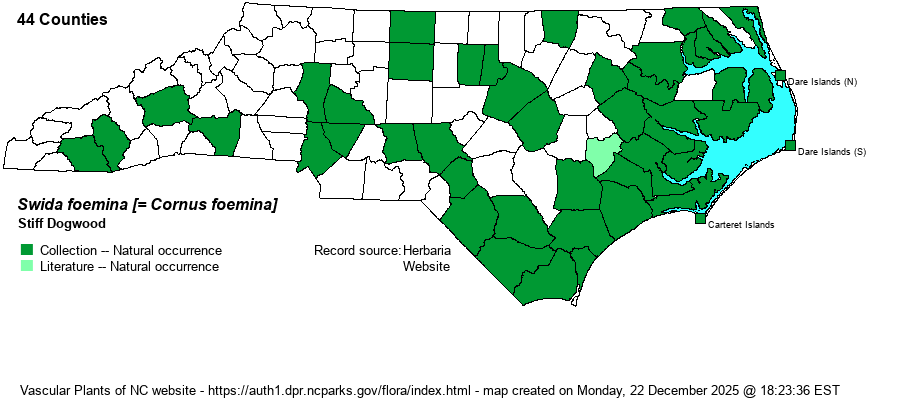| Author | (P. Miller) Rydberg | |
| Distribution | Ranges over most or all of the Coastal Plain, though more widespread in the lower half of the province. Scattered over much of the Piedmont, but rare to absent in the far western (foothills) region. A few records from the southern Mountains might be misidentifications (likely of C. amomum); certainly absent from the northern Mountains.
This is a Southern species, though it is certainly not a primarily Coastal Plain one. It ranges north to NJ, KY, and MO, and south to eastern TX and southern FL. However, it does essentially avoid the Appalachian Mountains.
| |
| Abundance | Fairly common to common in the lower half of the Coastal Plain, and at least fairly common in the upper half, but scarce (rare at best) in the Sandhills. Generally rare to uncommon and not well known in the Piedmont, where it is probably overlooked (as C. amomum). | |
| Habitat | As with C. amomum [Silky Dogwood], this species is a strictly wetland species and it occurs in similar habitats. It favors wet woods, including swamps and bottomlands, wet thickets, marsh edges, and stream banks, mostly in rich soils (as opposed to acidic wetlands). | |
| Phenology | Blooms in April and May, and fruits in July and August. | |
| Identification | This is a medium-sized shrub growing to about 9-10 feet tall, and often wider than tall. It has deciduous, opposite leaves that are slightly narrower than most similar dogwoods, though they are elliptical, entire, and about 3 inches long and seldom more than 1.5 inches wide. The very similar C. amomum has leaves usually 2 inches or more wide. This species has white pith inside the twigs, as opposed to a brown pith in C. amomum. Weakley (2018) says that this species has 3 or 4 veins on each side of the leaf, as opposed to usually 5 or more in C. amomum. Otherwise, both have a broad and flattened cluster of white flowers and blue berries. Usually, this is the dominant (if not only) one of these two wetland dogwoods in the Coastal Plain, and C. amomum the dominant or only one in much of the Piedmont and mountains. However, both occur in all three provinces, and thus one must take care with separation of these two species. See other references for additional separation characters. | |
| Taxonomic Comments | Weakley (2020) names this genus as Swida, following recommendations of several recent references. This species’ scientific epitaph has waffled between stricta (e.g., RAB 1968) and foemina (older references and Weakley 2018). Most recent references use foemina.
| |
| Other Common Name(s) | Swamp Dogwood, Southern Swamp Dogwood | |
| State Rank | S5 | |
| Global Rank | G5 | |
| State Status | | |
| US Status | | |
| USACE-agcp | | |
| USACE-emp | | |

